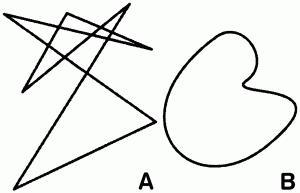Over at aeon, Shruti Ravindran discusses the fascinating possibility that we are born synaesthetes and never lose these abilities, though they are significantly altered – at least for most of us – during childhood development. If the research Ravindran summarizes is correct, it means at each of us slots somewhere along a synaesthetic spectrum. At first blush, this seems an extraordinary claim: the cross-modal sensory capacities of synaesthetes – such as smelling colors, hearing odors, or tasting words – is wonderfully exotic to those of us, the majority, who lack such abilities or experiences. But the majority may be more cross-modal than we think or perceive. Consider these two (nonsense) words — maluma and takete — and match them to the following images:
 If you are like most people (nearly ninety percent) in the world, you matched maluma with (B) and takete with (A). This apparently innate sound-shape correspondence has been cross-culturally confirmed with more recent experiments and is known as the bouba/kiki effect. After discussing this and other research which suggests we are all synesthetes, Ravindran observes that hypertrophied forms of it may be the “engine of metaphor and art.” To this list, I would add “religion” or experiences that are culturally construed as “mystical” and “spiritual.”
If you are like most people (nearly ninety percent) in the world, you matched maluma with (B) and takete with (A). This apparently innate sound-shape correspondence has been cross-culturally confirmed with more recent experiments and is known as the bouba/kiki effect. After discussing this and other research which suggests we are all synesthetes, Ravindran observes that hypertrophied forms of it may be the “engine of metaphor and art.” To this list, I would add “religion” or experiences that are culturally construed as “mystical” and “spiritual.”
The research on synaesthesia suggests we are diffusely wired at birth. During infancy and early childhood, “learning” largely consists of winnowing that wiring for specific tasks. This pruning occurs along particular pathways, which are strengthened so that we can perceive and respond with lightning speed along neurological superhighways. While this is tremendously useful, we pay a price for task specificity: our ability to associate is dampened. Our rhizomatic neural networks — those which enable novel associations and synaesthesia — fall by the wayside like so many side-roads. These may be the roads along which poets, novelists, musicians, and mystics prefer to drive or are better able to travel. For one reason or another, they may have experienced less pruning or narrowing, and thus are able to pursue pathways lost or forgotten by most of us.
As Ravindran aptly observes, this developmental model has a respectable pedigree, having been enthusiastically endorsed by William James:
The psychologist William James conjured a similar picture of the baby’s sensory world in his Principles of Psychology (1890). He wrote (and the excited capitalisations are all his) that ‘any number of impressions, from any number of sensory sources, falling simultaneously on a mind WHICH HAS NOT YET EXPERIENCED THEM SEPARATELY, will fuse into a single undivided object for that mind’. As a consequence, ‘The baby, assailed by eyes, ears, nose, skin, and entrails at once, feels it all as one great blooming, buzzing confusion; and to the very end of life, our location of all things in one space is due to the fact that the original extents or bignesses of all the sensations which came to our notice at once, coalesced together into one and the same space.’ If the Jamesian perceptual model held true, if most of us separate out the senses as we mature, could synaesthetes simply be continuing the process of fusion the majority leave behind? In other words, are all babies synaesthetic?
Although Ravindran does not make the connection, it surely is no accident that James was also interested in religious experiences, many mystical varieties of which resemble the perceptual fusion he hypothesizes for infants. While infants may experience this as “blooming, buzzing confusion,” adults who are neurologically less pruned may experience it “spiritually” in a manner similar to what Newberg and D’Aquili call “absolute unitary being.”
It is also interesting to note that this body of research shows an inverse relationship between synaesthesia and autism. Autistics, in other words, fall on the low end of the synaesthesia spectrum and have difficulty making cross-modal connections. Whereas close to ninety percent of people worldwide match the nonsense words maluma/takete and bouba/kiki with the same kinds of shapes (i.e., the first is rounded and second is jagged), for autistics this matching correlation drops to less than fifty percent. Here again we have a connection to religion, and perhaps even to prehistoric cognition, for it seems that many autistics cannot conceive of spirits or gods.

